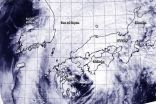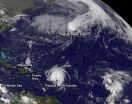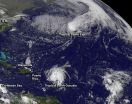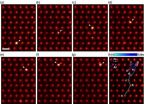(Press-News.org) Tropical Storm Vongfong continues to weaken as it tracks across the big islands of Japan, and NASA satellite data showed that westerly wind shear is taking its toll on the storm's structure.
On Oct. 12 at 0500 UTC (1 a.m. EDT), the MODIS instrument aboard NASA's Aqua satellite captured an image of Tropical Storm Vongfong approaching Japan. Despite weakening to a tropical storm, Vongfong still appeared to have an eye as its northeastern quadrant blanketed the large island of Kyushu, Japan. By 11 a.m. EDT, Maximum sustained winds had dropped to 55 knots (63 mph/102 kph). Vongfong was centered near 30.2 north latitude and 128.2 east longitude. That's about 231 nautical miles south-southwest of Sasebo, Japan.
On Monday, Oct. 13 at 04:05 UTC (12:05 a.m. EDT), Aqua flew over Vongfong again, and the MODIS instrument aboard saw that most of the clouds and showers were being pushed to the east of the storm by wind shear. At 0900 UTC (5 a.m. EDT), Vongfong's maximum sustained winds were down to 45 knots (51.7 mph/83.3 kph). The center of Vongfong were near 33.8 north latitude and 134.1 east longitude, about 84 nautical miles south-southeast of Iwakuni, Japan. Vongfong was moving to the northeast at 23 knots (26.4 mph/42.6 kph).
Forecasters at the Joint Typhoon Warning Center (JTWC) noted that the storm's low-level center was exposed to outside winds, an indication that the storm could weaken. The strongest thunderstorms (a tropical cyclone is made up of hundreds of them) were isolated in the eastern quadrant of the storm as a result of strong vertical wind shear. Winds buffeting the storm from the west were blowing as high as 50 knots, pushing those thunderstorms east of the center.
JTWC reported surface observations across Shikoku indicated light core winds. However, winds are stronger along the Shikoku coast sustained up to 35 knots (40 mph/65 kph) with isolated gusts to 56 knots (64.4 mph/103.7 kph) in the southeastern coast.
Vongfong is expected to become extra-tropical and continue moving northeast over Japan and exiting back into the western North Pacific on Oct. 14.
INFORMATION:
Rob Gutro
NASA's Goddard Space Flight Center
NASA satellite sees wind shear affecting Tropical Storm Vongfong
2014-10-14
ELSE PRESS RELEASES FROM THIS DATE:
Tropical Storm Gonzalo triggered many warnings in Eastern Caribbean
2014-10-14
The Eastern Caribbean islands were getting the brunt of Tropical Storm Gonzalo as the storm slowly moved through on Oct. 13. NASA's Terra satellite and NOAA's GOES-East satellite provided data on the storm. Gonzalo is the sixth named storm in the Atlantic Ocean Hurricane Season.
On Oct. 12 at 15:00 UTC (11:00 a.m. EDT), NASA's Terra satellite flew over Tropical Storm Gonzalo while it moved over the Lesser Antilles. The MODIS instrument captured a visible image of the storm that showed a concentration of strong thunderstorms around the center of circulation and in a thick ...
Satellites confirm Fay weakened to a Tropical Storm
2014-10-14
The fifth named Atlantic storm didn't maintain hurricane status long. Fay became a hurricane late on Oct. 12 and by early on Oct. 13, had weakened back to a tropical storm.
A visible image from NOAA's GOES-East satellite on Oct. 13 at 1145 UTC (7:45 a.m. EDT) showed Tropical Storm Fay northeast of Bermuda and Tropical Storm Gonzalo over the Lesser Antilles. Fay appeared circular, but didn't have the signature shape of a tropical storm like Gonzalo, with bands of thunderstorms spiraling into the center. The image was created by the NASA/NOAA GOES Project at NASA's Goddard ...
ORNL researchers make first observation of atoms moving inside bulk material
2014-10-14
OAK RIDGE, Tenn., Oct. 13, 2014 -- Researchers at the Department of Energy's Oak Ridge National Laboratory have obtained the first direct observations of atomic diffusion inside a bulk material. The research, which could be used to give unprecedented insight into the lifespan and properties of new materials, is published in the journal Physical Review Letters (06 October 2014, DOI: 10.1103/PhysRevLett.113.155501).
"This is the first time that anyone has directly imaged single dopant atoms moving around inside a material," said Rohan Mishra of Vanderbilt University who ...
Charged graphene gives DNA a stage to perform molecular gymnastics
2014-10-14
CHAMPAIGN, Ill. — When Illinois researchers set out to investigate a method to control how DNA moves through a tiny sequencing device, they did not know they were about to witness a display of molecular gymnastics.
Fast, accurate and affordable DNA sequencing is the first step toward personalized medicine. Threading a DNA molecule through a tiny hole, called a nanopore, in a sheet of graphene allows researchers to read the DNA sequence; however, they have limited control over how fast the DNA moves through the pore. In a new study published in the journal Nature ...
Scientists sniff out unexpected role for stem cells in the brain
2014-10-14
For decades, scientists thought that neurons in the brain were born only during the early development period and could not be replenished. More recently, however, they discovered cells with the ability to divide and turn into new neurons in specific brain regions. The function of these neuroprogenitor cells remains an intense area of research. Scientists at the National Institutes of Health (NIH) report that newly formed brain cells in the mouse olfactory system — the area that processes smells — play a critical role in maintaining proper connections. The results ...
Light-activated drug could reduce side effects of diabetes medication
2014-10-14
Scientists have created a drug for type 2 diabetes that is switched on by blue light, which they hope will improve treatment of the disease.
Diabetes drugs that promote the release of insulin from the pancreas can in some cases cause side effects due to their actions on other organs such as the brain and heart. Some can also stimulate too much insulin release, causing blood sugar levels to drop too low.
To help create better drugs, researchers at Imperial College London and LMU Munich adapted an existing type of drug called a sulfonylurea so that it changes shape when ...
New forecasting method: Predicting extreme floods in the Andes mountains
2014-10-14
This might allow for improved disaster preparedness. As the complex systems technique builds upon a mathematical comparison that can be utilised for any time series data, the approach could be applied to extreme events in all sorts of complex systems.
"Current weather forecast models cannot capture the intensity of the most extreme rainfall events, yet these events are of course the most dangerous, and can have severe impacts for the local population, for example major floods or even landslides," says lead author Niklas Boers of the Potsdam Institute for Climate Impact ...
Teenage baseball pitchers at risk for permanent shoulder injury
2014-10-14
OAK BROOK, Ill. – Young baseball pitchers who throw more than 100 pitches per week are at risk for a newly identified overuse injury that can impede normal shoulder development and lead to additional problems, including rotator cuff tears, according to a new study published online in the journal Radiology.
The injury, termed acromial apophysiolysis by the researchers, is characterized by incomplete fusion and tenderness at the acromion. The acromion, which forms the bone at the top or roof of the shoulder, typically develops from four individual bones into one bone ...
New clues behind the resilience of a leading sexually transmitted pathogen, Chlamydia
2014-10-14
In the advanced online edition of Molecular Biology and Evolution, authors Domman, et al. have explored factors behind the resilience of the most common sexually transmitted disease in the U.S., chlamydia, with an estimated 1 million infected.
The research team sequenced 4 new strains of close genetic cousins of chlamydial pathogens, and examined these with existing DNA data. They found an extensive and robust shuffling of the genomic deck between chlamydia families has played a major role in the evolution of the pathogen, often serving to outwit and exploit its hosts. ...
Study sheds light on factors that may contribute to pancreatic cancer
2014-10-14
New research that provides a better understanding of pancreatic cancer may help identify individuals at increased risk. The findings are published early online in Cancer, a peer-reviewed journal of the American Cancer Society.
Pancreatic cancer is a stealthy cancer that is usually detected at very late stages and has a 5-year survival rate of less than 5 percent. Strategies that might help identify which individuals have an increased risk of developing the disease are sorely needed. Some cases seem to run in families, but the genes that are responsible for such inherited ...







